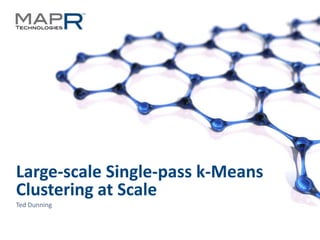
Graphlab dunning-clustering
- 1. Large-scale Single-pass k-Means Clustering at Scale Ted Dunning ©MapR Technologies - Confidential 1
- 2. Large-scale Single-pass k-Means Clustering ©MapR Technologies - Confidential 2
- 3. Large-scale k-Means Clustering ©MapR Technologies - Confidential 3
- 4. Goals Cluster very large data sets Facilitate large nearest neighbor search Allow very large number of clusters Achieve good quality – low average distance to nearest centroid on held-out data Based on Mahout Math Runs on Hadoop (really MapR) cluster FAST – cluster tens of millions in minutes ©MapR Technologies - Confidential 4
- 5. Non-goals Use map-reduce (but it is there) Minimize the number of clusters Support metrics other than L2 ©MapR Technologies - Confidential 5
- 6. Anti-goals Multiple passes over original data Scale as O(k n) ©MapR Technologies - Confidential 6
- 7. Why? ©MapR Technologies - Confidential 7
- 8. K-nearest Neighbor with Super Fast k-means ©MapR Technologies - Confidential 8
- 9. What’s that? Find the k nearest training examples Use the average value of the target variable from them This is easy … but hard – easy because it is so conceptually simple and you don’t have knobs to turn or models to build – hard because of the stunning amount of math – also hard because we need top 50,000 results Initial prototype was massively too slow – 3K queries x 200K examples takes hours – needed 20M x 25M in the same time ©MapR Technologies - Confidential 9
- 10. How We Did It 2 week hackathon with 6 developers from customer bank Agile-ish development To avoid IP issues – all code is Apache Licensed (no ownership question) – all data is synthetic (no question of private data) – all development done on individual machines, hosting on Github – open is easier than closed (in this case) Goal is new open technology to facilitate new closed solutions Ambitious goal of ~ 1,000,000 x speedup ©MapR Technologies - Confidential 10
- 11. How We Did It 2 week hackathon with 6 developers from customer bank Agile-ish development To avoid IP issues – all code is Apache Licensed (no ownership question) – all data is synthetic (no question of private data) – all development done on individual machines, hosting on Github – open is easier than closed (in this case) Goal is new open technology to facilitate new closed solutions Ambitious goal of ~ 1,000,000 x speedup – well, really only 100-1000x after basic hygiene ©MapR Technologies - Confidential 11
- 12. What We Did Mechanism for extending Mahout Vectors – DelegatingVector, WeightedVector, Centroid Shared memory matrix – FileBasedMatrix uses mmap to share very large dense matrices Searcher interface – ProjectionSearch, KmeansSearch, LshSearch, Brute Super-fast clustering – Kmeans, StreamingKmeans ©MapR Technologies - Confidential 12
- 13. Projection Search java.lang.TreeSet! ©MapR Technologies - Confidential 13
- 14. How Many Projections? ©MapR Technologies - Confidential 14
- 15. K-means Search Simple Idea – pre-cluster the data – to find the nearest points, search the nearest clusters Recursive application – to search a cluster, use a Searcher! ©MapR Technologies - Confidential 15
- 16. ©MapR Technologies - Confidential 16
- 17. x ©MapR Technologies - Confidential 17
- 18. ©MapR Technologies - Confidential 18
- 19. ©MapR Technologies - Confidential 19
- 20. x ©MapR Technologies - Confidential 20
- 21. But This Requires k-means! Need a new k-means algorithm to get speed – Hadoop is very slow at iterative map-reduce – Maybe Pregel clones like Giraph would be better – Or maybe not Streaming k-means is – One pass (through the original data) – Very fast (20 us per data point with threads) – Very parallelizable ©MapR Technologies - Confidential 21
- 22. Basic Method Use a single pass of k-means with very many clusters – output is a bad-ish clustering but a good surrogate Use weighted centroids from step 1 to do in-memory clustering – output is a good clustering with fewer clusters ©MapR Technologies - Confidential 22
- 23. Algorithmic Details Foreach data point xn compute distance to nearest centroid, ∂ sample u, if u > ∂/ß add to nearest centroid else create new centroid if number of centroids > 10 log n recursively cluster centroids set ß = 1.5 ß if number of centroids did not decrease ©MapR Technologies - Confidential 23
- 24. How It Works Result is large set of centroids – these provide approximation of original distribution – we can cluster centroids to get a close approximation of clustering original – or we can just use the result directly ©MapR Technologies - Confidential 24
- 25. Parallel Speedup? 200 Non- threaded ✓ 100 2 Tim e per point (μs) Threaded version 3 50 4 40 6 5 8 30 10 14 12 20 Perfect Scaling 16 10 1 2 3 4 5 20 Threads ©MapR Technologies - Confidential 25
- 26. Warning, Recursive Descent Inner loop requires finding nearest centroid With lots of centroids, this is slow But wait, we have classes to accelerate that! ©MapR Technologies - Confidential 26
- 27. Warning, Recursive Descent Inner loop requires finding nearest centroid With lots of centroids, this is slow But wait, we have classes to accelerate that! (Let’s not use k-means searcher, though) ©MapR Technologies - Confidential 27
- 28. Warning, Recursive Descent Inner loop requires finding nearest centroid With lots of centroids, this is slow But wait, we have classes to accelerate that! (Let’s not use k-means searcher, though) Empirically, projection search beats 64 bit LSH by a bit ©MapR Technologies - Confidential 28
- 29. Moving to Scale Map-reduce implementation nearly trivial Map: rough-cluster input data, output ß, weighted centroids Reduce: – single reducer gets all centroids – if too many centroids, merge using recursive clustering – optionally do final clustering in-memory Combiner possible, but essentially never important ©MapR Technologies - Confidential 29
- 30. Contact: – tdunning@maprtech.com – @ted_dunning Slides and such: – http://info.mapr.com/ted-mlconf Hash tags: #mlconf #mahout #mapr ©MapR Technologies - Confidential 30